Cyproheptadine for COVID-19

COVID-19 involves the interplay of over 200 viral and host proteins and factors providing many therapeutic targets.
Scientists have proposed over 10,000 potential treatments.
c19early.org analyzes
170+ treatments.
, The histamine receptor H1 acts as an alternative receptor for SARS-CoV-2, mBio, doi:10.1128/mbio.01088-24
ABSTRACT Numerous host factors, in addition to human angiotensin-converting enzyme 2 (hACE2), have been identified as coreceptors of severe acute respiratory syndrome coronavirus 2 (SARS-CoV-2), demonstrating broad viral tropism and diversified druggable potential. We and others have found that antihistamine drugs, particularly histamine receptor H1 (HRH1) antagonists, potently inhibit SARS-CoV-2 infection. In this study, we provided compelling evidence that HRH1 acts as an alternative receptor for SARS-CoV-2 by directly binding to the viral spike protein. HRH1 also synergistically enhanced hACE2-dependent viral entry by interacting with hACE2. Antihistamine drugs effectively prevent viral infection by competitively binding to HRH1, thereby disrupting the interaction between the spike protein and its receptor. Multiple inhibition assays revealed that antihistamine drugs broadly inhibited the infection of various SARS-CoV-2 mutants with an average IC50 of 2.4 µM. The prophylactic function of these drugs was further confirmed by authentic SARS-CoV-2 infection assays and humanized mouse challenge experiments, demonstrating the therapeutic potential of antihistamine drugs for combating coronavirus disease 19. IMPORTANCE In addition to human angiotensin-converting enzyme 2, severe acute respiratory syndrome coronavirus 2 (SARS-CoV-2) can utilize alternative cofactors to facilitate viral entry. In this study, we discovered that histamine receptor H1 (HRH1) not only functions as an independent receptor for SARS-CoV-2 but also synergistically enhances ACE2-dependent viral entry by directly interacting with ACE2. Further studies have demonstrated that HRH1 facilitates the entry of SARS-CoV-2 by directly binding to the N-terminal domain of the spike protein. Conversely, antihistamine drugs, primarily HRH1 antagonists, can competitively bind to HRH1 and thereby prevent viral entry. These findings revealed that the administration of repurposable antihistamine drugs could be a therapeutic intervention to combat coronavirus disease 19.
, Molecular docking as a tool for the discovery of novel insight about the role of acid sphingomyelinase inhibitors in SARS- CoV-2 infectivity, BMC Public Health, doi:10.1186/s12889-024-17747-z
AbstractRecently, COVID-19, caused by severe acute respiratory syndrome coronavirus 2 (SARS-CoV-2) and its variants, caused > 6 million deaths. Symptoms included respiratory strain and complications, leading to severe pneumonia. SARS-CoV-2 attaches to the ACE-2 receptor of the host cell membrane to enter. Targeting the SARS-CoV-2 entry may effectively inhibit infection. Acid sphingomyelinase (ASMase) is a lysosomal protein that catalyzes the conversion of sphingolipid (sphingomyelin) to ceramide. Ceramide molecules aggregate/assemble on the plasma membrane to form “platforms” that facilitate the viral intake into the cell. Impairing the ASMase activity will eventually disrupt viral entry into the cell. In this review, we identified the metabolism of sphingolipids, sphingolipids' role in cell signal transduction cascades, and viral infection mechanisms. Also, we outlined ASMase structure and underlying mechanisms inhibiting viral entry 40 with the aid of inhibitors of acid sphingomyelinase (FIASMAs). In silico molecular docking analyses of FIASMAs with inhibitors revealed that dilazep (S = − 12.58 kcal/mol), emetine (S = − 11.65 kcal/mol), pimozide (S = − 11.29 kcal/mol), carvedilol (S = − 11.28 kcal/mol), mebeverine (S = − 11.14 kcal/mol), cepharanthine (S = − 11.06 kcal/mol), hydroxyzin (S = − 10.96 kcal/mol), astemizole (S = − 10.81 kcal/mol), sertindole (S = − 10.55 kcal/mol), and bepridil (S = − 10.47 kcal/mol) have higher inhibition activity than the candidate drug amiodarone (S = − 10.43 kcal/mol), making them better options for inhibition.
, Drug Repurposing Screen for Compounds Inhibiting the Cytopathic Effect of SARS-CoV-2, Frontiers in Pharmacology, doi:10.3389/fphar.2020.592737
Drug repurposing is a rapid approach to identify therapeutics for the treatment of emerging infectious diseases such as COVID-19. To address the urgent need for treatment options, we carried out a quantitative high-throughput screen using a SARS-CoV-2 cytopathic assay with a compound collection of 8,810 approved and investigational drugs, mechanism-based bioactive compounds, and natural products. Three hundred and nineteen compounds with anti-SARS-CoV-2 activities were identified and confirmed, including 91 approved drugs and 49 investigational drugs. The anti-SARS-CoV-2 activities of 230 of these confirmed compounds, of which 38 are approved drugs, have not been previously reported. Chlorprothixene, methotrimeprazine, and piperacetazine were the three most potent FDA-approved drugs with anti-SARS-CoV-2 activities. These three compounds have not been previously reported to have anti-SARS-CoV-2 activities, although their antiviral activities against SARS-CoV and Ebola virus have been reported. These results demonstrate that this comprehensive data set is a useful resource for drug repurposing efforts, including design of new drug combinations for clinical trials for SARS-CoV-2.
Please send us corrections, updates, or comments.
c19early involves the extraction of 200,000+ datapoints from
thousands of papers. Community updates
help ensure high accuracy.
Treatments and other interventions are complementary.
All practical, effective, and safe
means should be used based on risk/benefit analysis.
No treatment or intervention is 100% available and effective for all current
and future variants.
We do not provide medical advice. Before taking any medication,
consult a qualified physician who can provide personalized advice and details
of risks and benefits based on your medical history and situation. IMA and WCH
provide treatment protocols.
Thanks for your feedback! Please search before submitting papers and note
that studies are listed under the date they were first available, which may be
the date of an earlier preprint.
